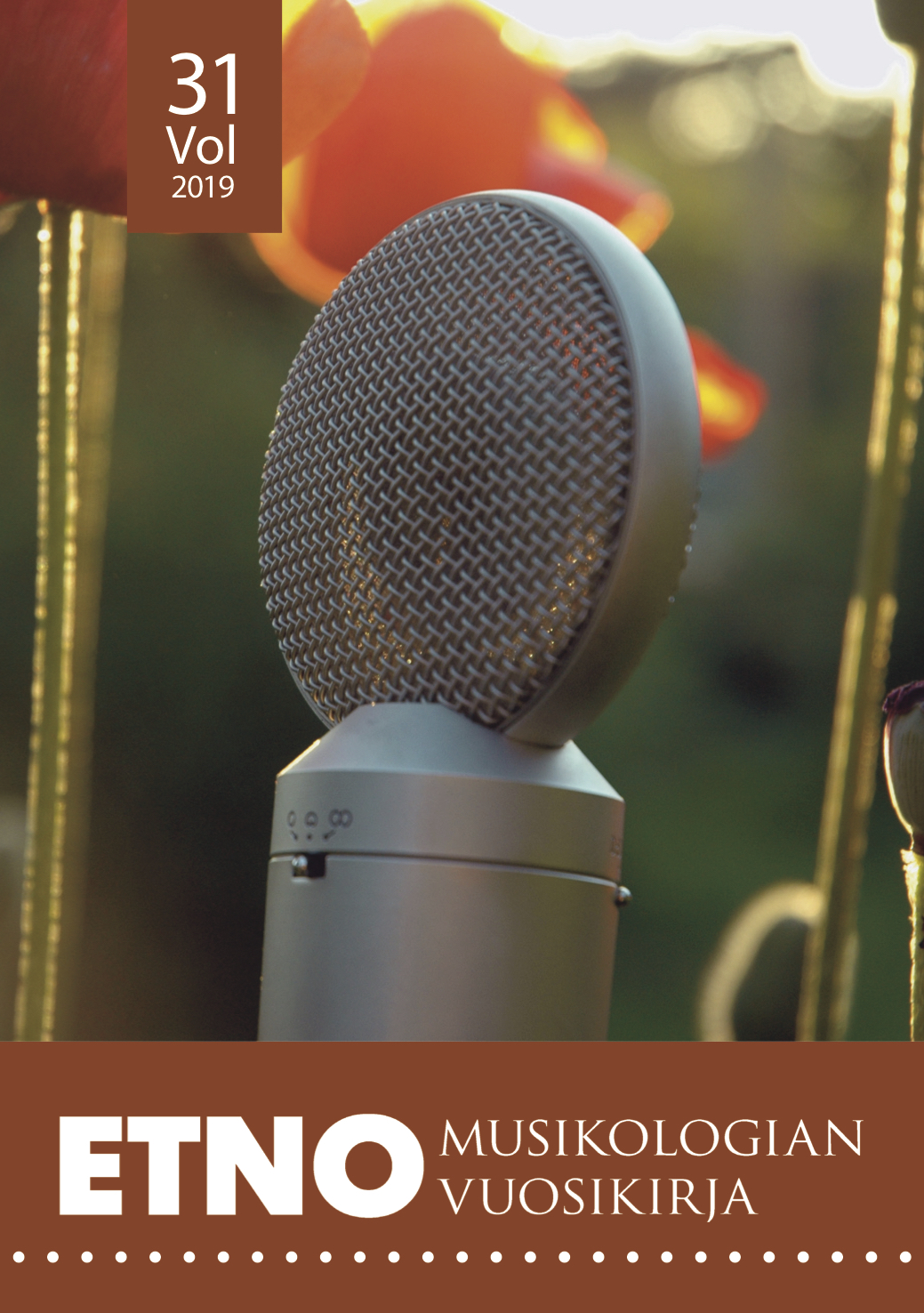Sunrise Avenue ja aitouden kaipuu
Autenttisuuden diskurssit populaarimusiikissa
DOI:
https://doi.org/10.23985/evk.81271Avainsanat:
autenttisuus, populaarimusiikki, Samu Haber, Sunrise Avenue, diskurssiAbstrakti
Autenttisuus on tutkimuksessa laajasti käsitelty aihe – jopa niin, että käsite tuntuu natisevan liitoksissaan yrittäessään kattaa näitä kaikkia lähestymistapoja. Populaarimusiikin tutkimuksessa käsite on ollut laajan keskustelun kohde, ja useimmiten nähty konstruktivistisesti, diskursiivisena tai performoituna ilmiönä. Käsitteellä on viitattu erilaisiin artistiin ja musiikkiin kohdistuviin odotuksiin, jotka usein nivoutuvat vilpittömyyden ja omaperäisyyden romanttiseen ideaaliin. Tässä artikkelissa esittelen aiempaa populaarimusiikin autenttisuustutkimusta ja pyrin synteesiin jo olemassa olevasta runsaasta tutkimuksesta ja diskursiivisista jaotteluista. Lisäksi ehdotan uusia teoreettisia ryhmittelyjä ja yhteenvetoja. Teoreettisen esittelyn ohella analysoin suomalaista Sunrise Avenue -yhtyettä käsitteleviä musiikkikritiikkejä, joiden tarkastelussa hyödynnän esiteltyjä teoreettisia malleja ja diskursseja. Sunrise Avenue -yhtyeen kritiikeissä rakentuvat diskurssit resonoivat aiemman keskustelun ja uusien jäsennysten kanssa painottaen muun muassa omaperäisyyden, vastarinnan, epäkaupallisuuden ja kohderyhmän autenttisuuden ihanteita.
Lähdeviitteet
Ojala, Pertti (2007) ”SUNRISE AVENUE: On The Way To Wonderland”. Soundi, 22.4.2007. https://www.soundi.fi/levyarviot/sunrise-avenue-way-wonderland/ (luettu 18.3.2019).
Ojala, Pertti (2009) ”SUNRISE AVENUE: Popgasm”. Soundi, 1.6.2009. https://www.soundi.fi/levyarviot/sunrise-avenue-popgasm/ (luettu 18.3.2019).
Rumba (2009) ”Sunrise Avenue – Popgasm”. Rumba, 15.5.2009. https://www.rumba.fi/arviot/sunrise-avenue-popgasm/ (luettu 18.3.2019).
Saarinen, Jussi (2011) ”Sunrise Avenue: Out of Style – ’Sunrise Avenue on uudistunut, mutta Samu Haber on jämähtänyt paikoilleen’”. Rumba, 24.3.2011. https://www.rumba.fi/arviot/sunrise-avenue-out-of-style-–-sunrise-avenue-on-uudistunut-mutta-samu-haber-on-jamahtanyt-paikoilleen/ (luettu 18.3.2019).
Vanhatalo, Kimmo (2013) ”Sunrise Avenue: Unholy Ground – Levy, joka saa hetkeksi vihaamaan kaikkea rockmusiikkia”. Rumba. (https://www.rumba.fi/arviot/sunrise-avenue-unholy-ground-levy-joka-saa-hetkeksi-vihaamaan-kaikkea-rockmusiikkia/ (luettu 18.3.2019).
Tutkimuskirjallisuus
Barker, Hugh & Yuval Taylor (2007) Faking It. The Quest for Authenticity in Popular Music. London: Faber and Faber.
Cobb, Russell (2014) ”Introduction: The Artifice of Authenticity in the Age of Digital Reproduction”. The Paradox of Authenticity in a Globalized World. Toim. R. Cobb. New York: Palgrave Macmillan, 1–10.
Davies, Helen (2001) ”All rock and roll is homosocial”. Popular Music 20:3, 301–319. https://doi.org/10.1017/S0261143001001519
Dutton, Denis (2009) ”Authenticity in Art”. http://www.oxfordhandbooks.com/view/10.1093/oxfordhb/9780199279456.001.0001/oxfordhb-9780199279456-e-14 (luettu 18.3.2019).
Emma-gaala. http://www.emmagaala.fi/fi/arkisto (luettu 25.4.2019).
Fetterley, Leanne Marie (2007) ”’Give Me Real, Don’t Give Me Fake’: Authenticity, Value, and Popular Music”. Doctoral thesis, Graduate Department of Music, University of Toronto.
Fornäs, Johan (1995a) Cultural Theory and Late Modernity. London: SAGE Publications.
Fornäs, Johan (1995b) ”The Future of Rock: Discourses That Struggle to Define a Genre”. Popular Music 14:1, 111–125. https://doi.org/10.1017/S0261143000007650
Frith, Simon (1981) ”’The Magic That Can Set You Free’: The Ideology of Folk and the Myth of the Rock Community”. Popular Music 1. Toim. Richard Middleton & David Horn. Cambridge: Cambridge University Press, 159–168.
Frith, Simon (1987) ”Towards an Aesthetic of Popular Music”. Music and society: The politics of composition, performance and reception. Toim. Richard Leppert & Susan McClary. Cambridge: Cambridge University Press, 133–149.
Frith, Simon (1996) Performing Rites. On the Value of Popular Music. Cambridge, MA: Harvard University Press.
Grierson, Tim (2019) ”A History of Post-Grunge Rock”. ThoughtCo, 28.1.2019. https://www.thoughtco.com/post-grunge-defined-2898292 (luettu 20.3.2019).
Grossberg, Lawrence (1992) We Gotta Get Out of This Place: Popular Conservatism and Postmodern Culture. New York: Routledge.
Grossberg, Lawrence (1993) ”The Media Economy of Rock Culture: Cinema, Post-Modernity and Authenticity.” Sound and Vision: The Music Video Reader. Toim. Simon Frith, Andrew Goodwin & Lawrence Grossberg. London: Routledge, 185–209.
Guignon, Charles (2004) On Being Authentic. London: Routledge.
Jones, Carys Wyn (2008) The Rock Canon: Canonical Values in the Reception of Rock Albums. Hampshire: Ashgate.
Ibarra, Herminia (2015) ”The Authenticity Paradox”. Harvard Business Review, Jan-Feb 2015. https://hbr.org/2015/01/the-authenticity-paradox (luettu 20.3.2019).
Karppinen, Anne (2012) Restless Multiplicities. Aspects of Sexual Difference in the Songs of Joni Mitchell. Julkaisematon käsikirjoitus. University of Jyväskylä.
Keightley, Keir (2001) ”Reconsidering Rock”. The Cambridge Companion to Pop and Rock. Toim. Simon Frith, Will Straw & John Street. Cambridge: Cambridge University Press, 109–142.
Kivy, Peter (1995) Authenticities: Philosophical Reflections on Musical Performance. Ithaca: Cornell University Press.
Lindberg, Ulf ym. (2005) Rock Criticism from the Beginning: Amusers, Bruisers, and Cool-Headed Cruisers. New York: Peter Lang.
Lindholm, Charles (2008) Culture and Authenticity. Malden: Blackwell.
Magill, R. Jay, Jr. (2012) Sincerity: How a Moral Ideal Born Five Hundred Years Ago Inspired Religious Wars, Modern Art, Hipster Chic, and the Curious Notion That We All Have Something to Say (No Matter How Dull). New York: Norton.
McLeod, Kembrew (2001) ”’*1/2’: A Critique of Rock Criticism in North America”. Popular Music 20:1, 47–60. https://doi.org/10.1017/S0261143001001301
McLeod, Kembrew (2002) ”Between Rock and a Hard Place. Gender and Rock Criticism”. Pop Music and the Press. Toim. Steve Jones. Philadelphia: Temple University Press, 93–113.
Meier, Leslie M. (2008) “In Excess? Body Genres, ‘Bad’ Music, and the Judgment of Audiences.” Journal of Popular Music Studies 20, 240–260. https://doi.org/10.1111/j.1533-1598.2008.00160.x.
Moore, Allan (2002) ”Authenticity as Authentication”. Popular Music 21:2, 209–223. https://doi.org/10.1017/S0261143002002131
Peterson, Richard A. (1997) Creating Country Music: Fabricating Authenticity. Chicago: The University of Chicago Press.
Sherman, Bernard D. (1998) ”Authenticity in Musical Performance”. The Encyclopedia of Aesthetics. Toim. Michael J. Kelly. New York: Oxford University Press.
Shuker, Roy (2012) Popular Music Culture: The Key Concepts. 3. painos. London: Routledge.
Shuker, Roy (2013) Understanding Popular Music Culture. 4. painos. London: Routledge.
Sinanan, Kerry & Tim Milnes (2010) ”Introduction”. Romanticism, Sincerity and Authenticity. Toim. Tim Milnes & Kerry Sinanan. Basingstoke: Palgrave Macmillan, 1–30.
Speers, Laura (2017) Hip-Hop Authenticity and the London Scene. Living Out Authenticity in Popular Music. London: Routledge.
Taylor, Charles (1991) The Ethics of Authenticity. Cambridge: Harvard University Press.
Taylor, Timothy D. (1997) Global Pop: World Music, World Markets. New York: Routledge.
Warwick, Jacqueline (2009) ”Singing Style and White Masculinity”. The Ashgate Research Companion to Popular Musicology. Toim. Derek B. Scott. Farnham: Ashgate, 349–364.
Weinstein, Deena (1999) ”Art Versus Commerce: Deconstructing a (Useful) Romantic Illusion”. Stars Don’t Stand Still in the Sky: Music and Myth. Toim. Karen Kelly & Evelyn McDonnell. London: Routledge, 57–69.
Weinstein, Deena (2004) ”Creativity and Band Dynamics”. This Is Pop: In Search of the Elusive at Experience Music Project. Toim. Eric Weisbard. Cambridge: Harvard University Press, 187–199.
Weisethaunet, Hans & Ulf Lindberg (2010) ”Authenticity Revisited: The Rock Critic and the Changing Real”. Popular Music and Society 33:4, 465–485. https://doi.org/10.1080/03007761003694225





